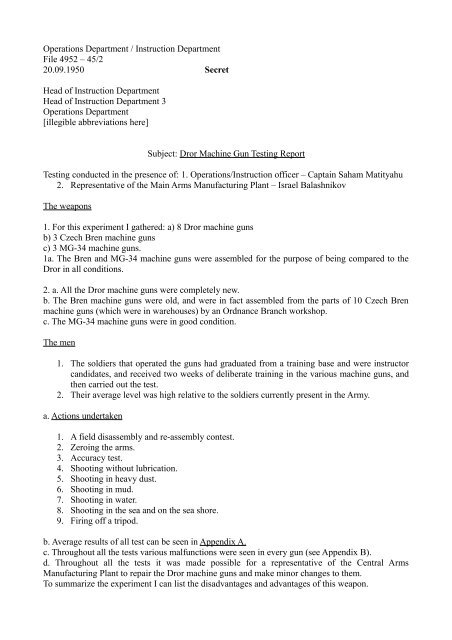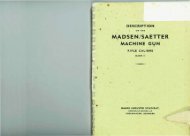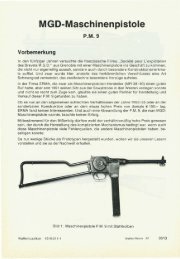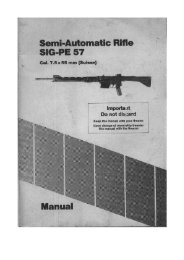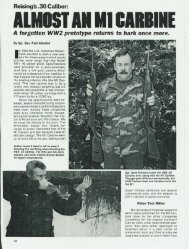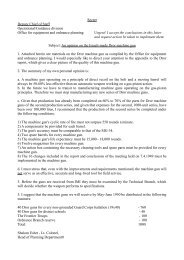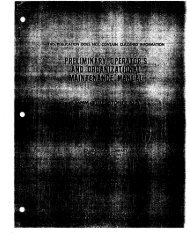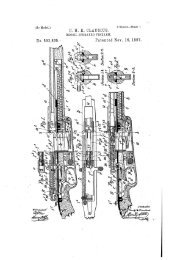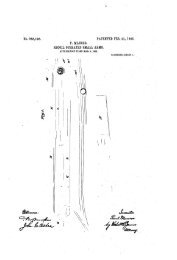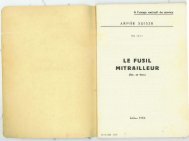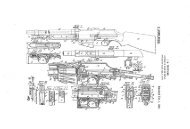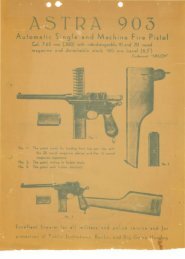Dror MG test report Sept 1950.pdf - Forgotten Weapons
Dror MG test report Sept 1950.pdf - Forgotten Weapons
Dror MG test report Sept 1950.pdf - Forgotten Weapons
You also want an ePaper? Increase the reach of your titles
YUMPU automatically turns print PDFs into web optimized ePapers that Google loves.
Operations Department / Instruction Department<br />
File 4952 – 45/2<br />
20.09.1950 Secret<br />
Head of Instruction Department<br />
Head of Instruction Department 3<br />
Operations Department<br />
[illegible abbreviations here]<br />
Subject: <strong>Dror</strong> Machine Gun Testing Report<br />
Testing conducted in the presence of: 1. Operations/Instruction officer – Captain Saham Matityahu<br />
2. Representative of the Main Arms Manufacturing Plant – Israel Balashnikov<br />
The weapons<br />
1. For this experiment I gathered: a) 8 <strong>Dror</strong> machine guns<br />
b) 3 Czech Bren machine guns<br />
c) 3 <strong>MG</strong>-34 machine guns.<br />
1a. The Bren and <strong>MG</strong>-34 machine guns were assembled for the purpose of being compared to the<br />
<strong>Dror</strong> in all conditions.<br />
2. a. All the <strong>Dror</strong> machine guns were completely new.<br />
b. The Bren machine guns were old, and were in fact assembled from the parts of 10 Czech Bren<br />
machine guns (which were in warehouses) by an Ordnance Branch workshop.<br />
c. The <strong>MG</strong>-34 machine guns were in good condition.<br />
The men<br />
1. The soldiers that operated the guns had graduated from a training base and were instructor<br />
candidates, and received two weeks of deliberate training in the various machine guns, and<br />
then carried out the <strong>test</strong>.<br />
2. Their average level was high relative to the soldiers currently present in the Army.<br />
a. Actions undertaken<br />
1. A field disassembly and re-assembly con<strong>test</strong>.<br />
2. Zeroing the arms.<br />
3. Accuracy <strong>test</strong>.<br />
4. Shooting without lubrication.<br />
5. Shooting in heavy dust.<br />
6. Shooting in mud.<br />
7. Shooting in water.<br />
8. Shooting in the sea and on the sea shore.<br />
9. Firing off a tripod.<br />
b. Average results of all <strong>test</strong> can be seen in Appendix A.<br />
c. Throughout all the <strong>test</strong>s various malfunctions were seen in every gun (see Appendix B).<br />
d. Throughout all the <strong>test</strong>s it was made possible for a representative of the Central Arms<br />
Manufacturing Plant to repair the <strong>Dror</strong> machine guns and make minor changes to them.<br />
To summarize the experiment I can list the disadvantages and advantages of this weapon.
Disadvantages<br />
1. Disassembling the weapon is difficult and almost impossible to perform when prone.<br />
2. The charging handle is part of the bolt, therefore: a. The handle is small and uncomfortable,<br />
injures the hand. b. Releasing the lock while cocking often injures the hand.<br />
3. The magazine well faces downwards.<br />
4. Inserting the magazine is difficult.<br />
5. Bad feed (causes many malfunctions).<br />
6. Overly forceful ejection tears the rim.<br />
7. Torn rims fall into the magazine and causes stoppages in the functioning of the machine gun<br />
that cannot be overcome by soldiers in the field.<br />
8. Barrel replacement is difficult.<br />
9. The place where the barrel is held is not at the resting point.<br />
10. Very sensitive to a lack of oil (does not function).<br />
11. Very sensitive to dust (does not function).<br />
12. Very sensitive to mud (does not function).<br />
13. Very sensitive to water (does not function).<br />
14. Very sensitive to sea water and sea shore sand (does not function). (In all of these<br />
experiments there had been incidents where the moving parts stopped and could not be<br />
moved, which made disassembly difficult) [this is noted on the side of the page next to<br />
points 12-14 so I estimate it only means these parts of the experiments – I cannot be certain<br />
though]<br />
15. Primer ignition is not certain (often stops).<br />
16. Due to inaccuracy in manufacturing, magazines that fit one gun do not always fit the other<br />
one.<br />
17. Selection is not accurate.<br />
18. Great dispersion during automatic fire.<br />
19. Releasing the trigger does not always cause gun to stop firing.<br />
Advantages:<br />
1. Light and comfortable to carry.<br />
2. In semi-automatic fire it is more accurate than all the other firearms.<br />
In light of this summary, I see no possibility that this firearm be adopted by the Army.<br />
Captain Shaham Matityahu<br />
On behalf of Instruction Department 3<br />
1. a. Field disassembling con<strong>test</strong><br />
b. Zeroing the weapons.<br />
Appendix A<br />
To the <strong>Dror</strong> Machine Gun Testing Report<br />
a.<br />
1. Disassembling con<strong>test</strong>s were held on Olga Hill on one of the shooting stations.<br />
2.Dis-assembly included removing the stock and action of the firearm.<br />
3. The con<strong>test</strong> was held in pairs, starting at a firing-ready position and ending at a firingready<br />
position.<br />
4. Before the <strong>test</strong> a representative of the Central Arms Manufacturing Plant passed between<br />
the men with a file, filing down the stock catch on the <strong>Dror</strong> to make disassembling easier.
Average results:<br />
<strong>Dror</strong>: 1.57 min. Bren: 0.26 min. <strong>MG</strong> 34: 1.58 min.<br />
b.<br />
1. Zeroing was conducted at a range of 100 yards.<br />
2. Despite the fact that the crates in which the <strong>Dror</strong> machine guns came were marked 'after<br />
zeroing', we were forced to zero 6 out of 8 firearms.<br />
2. Accuracy <strong>test</strong>ing:<br />
a. This <strong>test</strong>ing was conducted at a regular range for all machine guns at the following ranges:<br />
200 meters, automatic fire, 20 rounds to a target 120 by 120 centimeters in size.<br />
200 meters, semi-automatic fire, 10 rounds to a target 120 by 120 centimeters in size.<br />
300 meters, automatic fire, 20 rounds to a target 120 by 120 centimeters in size, in 40 seconds.<br />
400 meters, semi-automatic fire, 10 rounds to a target 120 by 120 centimeters in size, in 60 seconds.<br />
400 meters, automatic fire, 20 rounds to a target 120 by 120 centimeters in size, in 60 seconds.<br />
600 meters, semi-automatic fire, 10 rounds to a target 120 by 120 centimeters in size, in 90 seconds.<br />
600 meters, automatic fire, 20 rounds to a target 120 by 120 centimeters in size, in 90 seconds.<br />
Average results:<br />
<strong>Dror</strong>: 200 meters, semi-automatic fire, 30.8 points out of a maximum of 40<br />
<strong>Dror</strong>: 200 meters, automatic fire, 27.8 points out of a maximum of 80<br />
<strong>Dror</strong>: 300 meters, automatic fire, 5 points out of a maximum of 80<br />
Note: Some of the machine-guns did not complete firing their 20 rounds due to stoppages.<br />
<strong>Dror</strong>: 400 meters, semi-automatic fire, 8.7 points out of a maximum of 40<br />
Note: On average, only 7 rounds were fired due to stoppages.<br />
<strong>Dror</strong>: 400 meters, automatic fire, 1.6 points out of a maximum of 80<br />
Note: On average, only 14 rounds were fired due to stoppages.<br />
<strong>Dror</strong>: 600 meters, semi-automatic fire, 2 points out of a maximum of 40<br />
Note: On average, only 7.2 rounds were fired due to stoppages.<br />
<strong>Dror</strong>: 600 meters, automatic fire, 2 points out of a maximum of 80<br />
<strong>MG</strong>-34:<br />
: 200 meters, semi-automatic fire, 24 points out of a maximum of 40<br />
: 200 meters, automatic fire, 18 points out of a maximum of 80<br />
: 300 meters, automatic fire, 5.5 points out of a maximum of 80<br />
Note: 19 rounds only fired due to stoppages.<br />
: 400 meters, semi-automatic fire, 8.1 points out of a maximum of 40<br />
: 400 meters, automatic fire, 1.6 points out of a maximum of 80<br />
: 600 meters, semi-automatic fire, 3.3 points out of a maximum of 40<br />
Note: 6 rounds only fired due to stoppages.<br />
: 600 meters, automatic fire, 7 points out of a maximum of 80
Bren:<br />
: 200 meters, semi-automatic fire, 27 points out of a maximum of 40 (all rounds fired)<br />
: 200 meters, automatic fire, 35 points out of a maximum of 80<br />
: 300 meters, automatic fire, 7 points out of a maximum of 80<br />
Note: Some of the machine-guns did not complete firing their 20 rounds due to<br />
stoppages.<br />
: 400 meters, semi-automatic fire, 8 points out of a maximum of 40<br />
: 400 meters, automatic fire, 6.3 points out of a maximum of 80<br />
Only 19 rounds were fired due to stoppages.<br />
: 600 meters, semi-automatic fire, 1 points out of a maximum of 40<br />
: 600 meters, automatic fire, 3.3 points out of a maximum of 80<br />
3. Shooting without oil:<br />
The machine guns have been cleaned, all moving parts dried of oil,<br />
except for the trigger mechanism where soldiers cannot normally reach. Every machine<br />
gunner had to fire 50 rounds on semi-automatic and 100 rounds on automatic fire.<br />
The results are as follows:<br />
a) The <strong>Dror</strong> machine guns: Except for one machine gun which functioned normally, the other 7<br />
machine guns could not fire the 50 rounds of semi-automatic fire and ceased functioning.<br />
b) We attempted firing some of the guns on automatic fire before they completed the 50 rounds of<br />
semi-automatic fire. Some fired bursts even after the trigger was released, and then also<br />
malfunctioned.<br />
c) Even after a representative of the Central Arms Manufacturing Plant received permission to clean<br />
the chamber with steel wool and file the locking teeth in some of the machine guns it did not help.<br />
d) The Bren machine guns: Functioned normally.<br />
e) The <strong>MG</strong>-34 guns: Fired well on semi-automatic, but experienced several ejection stoppages on<br />
automatic fire.<br />
After the <strong>test</strong> all firearms were cleaned and re-oiled according to all the rules for cleaning firearms<br />
before shooting.<br />
4. Shooting in heavy dust: We made use of the wind, positioning loaded machine guns and pouring<br />
sand near them to fill the guns with dust. After this every machine gun was assigned 50 rounds for<br />
semi-automatic and 100 rounds for automatic fire.<br />
The results are as follows:<br />
a) The <strong>Dror</strong> machine guns: None of the machine guns functioned.<br />
b) We attempted to use them as rifles, feeding and extracting using the bolt handle. Some of the<br />
men received injuries to their hands from the bolt handle.<br />
c) In some of the machine guns the moving parts were stuck mid-way and could not be moved by<br />
hand. We were forced to disassemble the guns, and even that was only possible with great difficulty.<br />
d) Those machine guns that we managed to operate as rifles failed to pierce the primer.<br />
e) The Bren machine guns: Functioned normally after the bolt was 'played with' by moving it back<br />
and forth without rounds.<br />
f) The <strong>MG</strong>-34 guns: All machineguns fired on semi-automatic, but experienced many ejection
stoppages on automatic fire and eventually ceased functioning altogether.<br />
After the <strong>test</strong> all firearms were cleaned and re-oiled according to all the rules for cleaning firearms<br />
before shooting.<br />
5. Shooting in mud: We located clay/sandy soil in the area in the area, and made it into mud. We<br />
placed all the machine guns in it loaded, except for the <strong>MG</strong>-34 guns, which were unloaded when<br />
placed in the mud. After this every machine gun was assigned 50 rounds for semi-automatic and<br />
100 rounds for automatic fire.<br />
a) The <strong>Dror</strong> machine guns: None of the machine guns functioned.<br />
b) The Bren machine guns: 2 out of 3 machine guns functioned well after the bolt assembly was<br />
“played with” by moving it back and forth several times while the gun was unloaded. The third<br />
machine gun failed due to gunner error as the latter removed the barrel, at which point mud entered<br />
the barrel catch, and he was unable to put the gun back together again.<br />
c) The <strong>MG</strong>-34 machine guns: Did not function at all.<br />
After the <strong>test</strong> all firearms were cleaned and re-oiled according to all the rules for cleaning firearms<br />
before shooting.<br />
6. Testing of shooting after dipping into water:<br />
Due to the fact that sweet water was impossible to procure, we dipped the firearms into seawater for<br />
a period of 4-5 seconds only.<br />
The results are as follows:<br />
a) The <strong>Dror</strong> machine guns: Functioned only as rifles, the machine gunners being forced to remove<br />
spent cases and insert new cartridges by hand. This caused many of our men to be injured, and the<br />
others developed pains and swelling in their hands.<br />
b) The Bren machine guns: One of the machine guns functioned well, another fired only in semiautomatic,<br />
and the third did not function at all.<br />
c) The <strong>MG</strong>-34 machine guns: Only one of the machine guns functioned well.<br />
After the <strong>test</strong> all firearms were cleaned and re-oiled according to all the rules for cleaning firearms<br />
before shooting.<br />
7. Testing of shooting after dipping into seawater and sea-shore sand: We dipped the firearms<br />
into the sea for approximately 5 seconds, and then poured sea-shore sand on them.<br />
The results are as follows:<br />
a) The <strong>Dror</strong> machine guns: Did not function.<br />
b) The Bren machine guns: Did not function.<br />
c) The <strong>MG</strong>-34 machine guns: Did not function.<br />
8. Tripod firing <strong>test</strong>: The machine guns were attached, using adapter links, to universal Bren tripods.<br />
One must note that the adapters for the Czech-made Bren were made in a very bad quality, which<br />
caused instability in the firearm, while the <strong>MG</strong>-34 and <strong>Dror</strong> machine guns were relatively stable.<br />
The <strong>test</strong> was conducted thus: each machine gun was loaded with a 20-round magazine, while the
<strong>MG</strong>-34 machine guns received a 20-round belt.<br />
After this every machine gun was aimed at a target, and the Brens were adjusted for stability. After<br />
aiming every machine gunner fired his 20 rounds in regular service bursts without altering his aim.<br />
Here are the results in terms of the size of the hit area:<br />
a) <strong>Dror</strong> machine guns: 77.4 centimeters in length, 61 centimeters in width.<br />
b) Bren machine guns: 75 centimeters in length, 50 centimeters in width.<br />
c) <strong>MG</strong>-34 machine guns: 78 centimeters in length, 69 centimeters in width.<br />
Captain Shaham Matityahu<br />
On behalf of Instruction Department 3<br />
Summary table for accuracy <strong>test</strong><br />
Semi-automatic fire<br />
Range <strong>MG</strong>-34 Bren <strong>Dror</strong> Maximum points<br />
200 24 27 30 40<br />
300 40<br />
400 8.1 8 8.7 40<br />
600 3.3 1 2 40<br />
Automatic fire<br />
Range <strong>Dror</strong> Maximum points<br />
200 18 35 27.3 80<br />
300 5.5 7 5 80<br />
400 1.7 5.3 1.6 80<br />
600 7 3.3 2 80<br />
Appendix B:<br />
Following below is a list of stoppages as they occured in the various machine guns by day. The<br />
stoppages listed below occurred in most of the machine guns. This list omits stoppages that<br />
occurred in only one or two machine guns.<br />
1. Day One:<br />
a) <strong>Dror</strong> machine guns:<br />
1. Magazine is difficult to insert<br />
2. On automatic fire the gun continues firing after the shooter lets go of the<br />
trigger.<br />
3. Failure to feed.<br />
4. Failure to detach.<br />
5. Torn rim.<br />
b) Bren machine guns:
1. No stoppages.<br />
c) <strong>MG</strong>-34 machine guns:<br />
2. No stoppages.<br />
2. Day Two:<br />
a) <strong>Dror</strong> machine guns:<br />
1. Does not lock properly.<br />
2. Failure to detach.<br />
3. Stopped piercing the primer (reason unknown)<br />
4. Failure to eject.<br />
5. Torn rim.<br />
6. Failure to detach due to torn rim.<br />
7. Difficult to insert magazine.<br />
8. Faulty feed.<br />
9. On automatic fire the gun continues firing after the shooter lets go of the<br />
trigger.<br />
10. At 200 meters we were forced to raise the sights to 400.<br />
b) Bren machine guns:<br />
1. No stoppages.<br />
c) <strong>MG</strong>-34 machine guns:<br />
1. Failure to detach (occurs rarely).<br />
3. Day Three:<br />
a) <strong>Dror</strong> machine guns:<br />
Same stoppages previously seen.<br />
4. b) Bren machine guns: No stoppages.<br />
c) <strong>MG</strong>-34 machine guns:<br />
1. No stoppages.<br />
5. Day Four<br />
a) <strong>Dror</strong> machine guns:<br />
1. Same stoppages as previously seen (and see Appendix A on dipping <strong>test</strong>).<br />
b) Bren machine guns:<br />
1. No stoppages (and see Appendix A on dipping <strong>test</strong>).<br />
c) <strong>MG</strong>-34 machine guns:<br />
1. Hard detaching.<br />
On other days, wherein we conducted dipping, stoppages have not been recorded in detail since our<br />
goal was to see whether the firearm functions at all. An answer to that question can be seen in<br />
Appendix A.<br />
Captain Shaham Matityahu<br />
On behalf of Instruction Department 3


